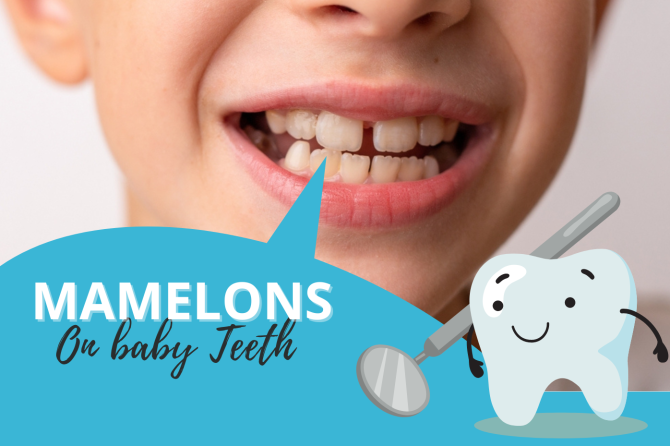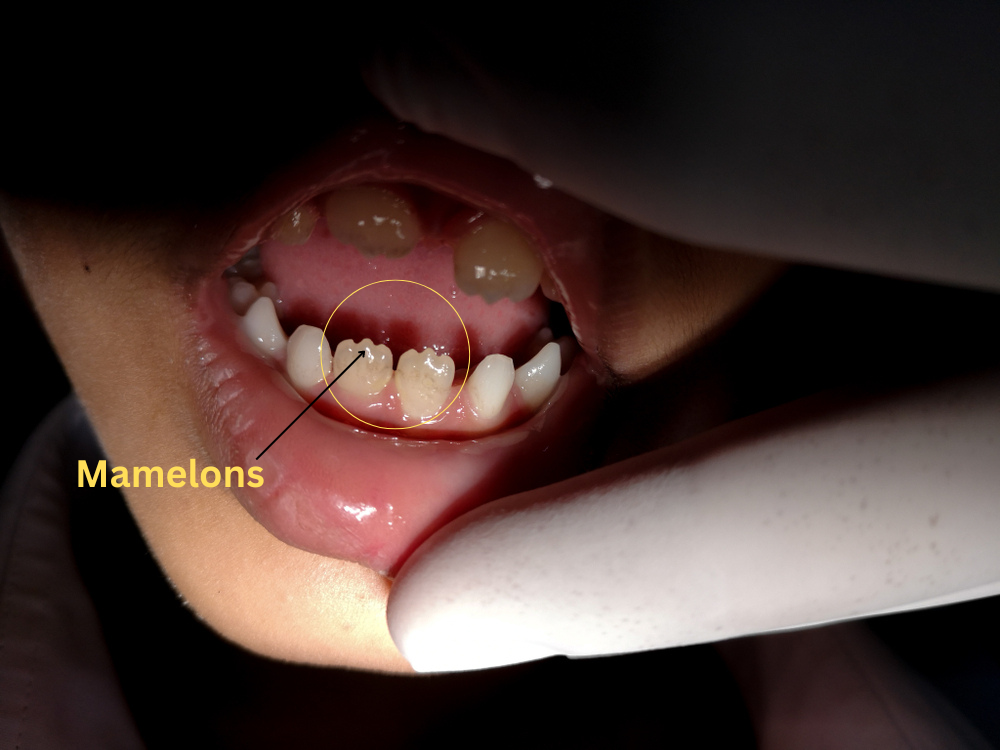
Mamelons On baby Teeth: What Are These & How To Treat Them
Have you ever noticed little bumps or ridges on a young child’s teeth? Those are called mamelons, and they’re a completely normal part of a tooth’s development. Keep reading to learn what mamelons are, when they form, why we have them, and what to do if they don’t wear down properly.
What Are Mamelons?

Mamelons on Teeth are small bumps or ridges that are present on the biting surfaces of primary (baby) teeth and permanent teeth when they first erupt through the gums.
Mamelons are made up of enamel, which is the hard, outer surface of a tooth. During tooth development, enamel forms in layers that stack on top of each other. The mamelons represent the distinct lobes of enamel that come together to create the chewing surface of a tooth. They serve an important purpose in the growth process.
When Do Mamelons On Teeth Form?
Mamelons begin forming while teeth are still developing under the gums. The process starts in utero before a baby is even born! As the enamel layer of a tooth crown takes shape, it does so in a wavy, lobed pattern. The high points of the waves become the mamelons. This gives each tooth small bumps or ridges on its chewing surface once it emerges.
Mamelons on Teeth are most noticeable on primary (baby) teeth. That’s because the enamel on primary teeth is thinner. The bumps stand out more visibly as a result.
On permanent teeth, the enamel is thicker overall. This makes the Mamelons in Dentistry
flatter and more subtle in appearance. But they are still present in the grooves and pits that form the chewing surfaces of adult teeth.
What Happens to Mamelons On Teeth Over Time?
Mamelons in Dentistry are only meant to be temporary. They typically wear down and disappear within the first few years after a tooth erupts. This process happens through normal use as the child begins actively chewing and eating a variety of foods.
The enamel bumps essentially act as “cushions” against the force of the opposing tooth. Mamelons wear down faster than the rest of the enamel surface because they stick out more. This evens out the chewing surface into a flatter and smoother texture.
By age 3-4 years for primary teeth (and early teenage years for adult teeth), most kids have worn down the mamelons completely through the natural process of using their teeth. The chewing surfaces become more uniform in appearance.
This transformation is normal and expected. In fact, it’s a sign that the teeth are in active use and developing properly. The mamelons are serving their short-term purpose before becoming integrated into the overall enamel surface.
Potential Problems with Wearing Down Mamelons
For most kids, the mamelons wear away on schedule as the teeth erupt. But in some cases, the bumps may be stubborn and stick around longer than expected. This can indicate problems with tooth eruption or bite alignment:
- Delayed eruption – Teeth that emerge later or more slowly may keep mamelons longer since they aren’t being used.
- Reduced chewing – A child who has difficulty chewing or eats only soft foods won’t wear down mamelons at a typical pace.
- Misalignment – If the bite is off, mamelons on the opposing teeth may not connect consistently, preventing even wear.
- Enamel issues – Weak spots or thin areas in enamel can cause uneven mamelon wear.
Kids with autism or sensory issues may also avoid chewing enough to wear down mamelons on schedule. Any disruption to the normal eruption and development process can prolong the bumps past the expected timeframe.
What To Do About Persistent Mamelons
If a child still has noticeable Mamelons on Teeth past age 3-4 years, it’s a good idea to have their teeth evaluated by a pediatric dentist. A dental exam can identify any underlying causes for the delayed wear.
The dentist may recommend specific treatment approaches to eliminate stubborn mamelons and smooth out the biting surfaces:
- Bite adjustment – Reshaping high spots with dental tools can manually remove excess mamelon bumps.
- Occlusal grinding – A gentle sanding technique can mechanically grind down mamelons to flatten chewing surfaces.
- Enamel microabrasion – An acidic gel is applied to loosen and wear down enamel high spots on the teeth.
- Composite reshaping – Bonding material can fill in depressed mamelon pits to even out the tooth contour.
- Crowns – In severe cases, placing crowns may be needed to fully restore normal chewing function.
The goal of any mamelon removal method is to normalise the bite and establish proper contact between the top and bottom teeth. This should help resolve any chewing difficulties the child is experiencing.
Once the Mamelons in Dentistry are worn down, the dentist will continue monitoring tooth development at regular checkups. As long as the bite alignment remains stable, the child can resume normal wear and maturation of the tooth surfaces over time.
Caring for Teeth During Mamelon Wear Down
To help support the body’s natural process of wearing down dental mamelons, there are a few things parents can do:
- Provide chewy foods – Offer crunchy fruits and vegetables or chewy meats to give teeth a workout! This promotes healthy mamelon wear.
- Check for teeth grinding – Consult your dentist if excessive teeth grinding could be delaying mamelon removal. A mouth guard may help.
- Monitor sugar intake – Limit sugary treats and juice that can weaken enamel over time, interfering with even wear.
- Brush and floss – Gently clean teeth twice daily to prevent food buildup in mamelon grooves that could encourage cavities.
- Use fluoride – Fluoride strengthens and protects tooth enamel. Ask your dentist about supplements if needed.
When to See a Pediatric Dentist
Beyond mamelon monitoring, the American Academy of Pediatric Dentistry recommends children see a dentist by age 1, or within 6 months of their first tooth erupting.
Pediatric dentistry receive 2-3 additional years of specialized training to provide skilled, kid-friendly care. They know how to make dental visits a positive experience for children.
In addition to checking mamelon wear, the paediatric dentist will look for any problems with emerging teeth, including:
– Cavities
– Discoloration
– Enamel defects
– Misalignment with other teeth
– Delayed eruption
They can also assess bite and jaw alignment issues that may interfere with normal mamelon removal. Catching any problems early improves the chance of quick, successful treatment.
Conclusion
The bumpy dental mamelons you see on a young child’s new teeth are completely normal. They help emerging teeth stabilize and function properly.
With regular chewing and biting force, mamelons wear down by age 3-4, leaving a smoother tooth surface. If some stubborn mamelons remain past this age, consult a dentist for smoothing treatment options.
For all of your child’s oral health needs, Kids Dental Studio is an excellent option if you’re searching for a pediatric dentist in Ahmedabad. It is run by skilled pediatric dentists Dr. Umangi and Dr. Kisha Mehta, who are committed to giving kids the best dental care possible. Kids Dental Studio has received great reviews from parents in Ahmedabad for its professional approach to pediatric dentistry, pleasant staff, and exceptional service.
Leave a reply
